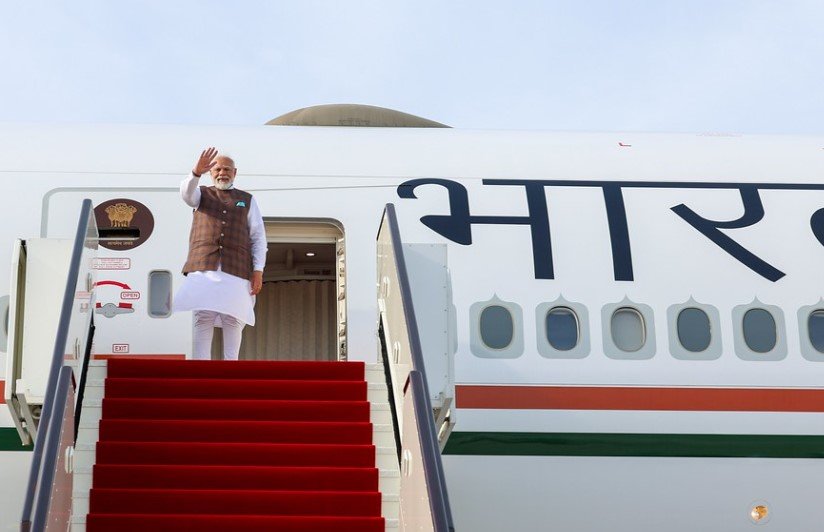Prime Minister Narendra Modi took off Tuesday morning on a whirlwind diplomatic tour that’s all about influence, alliances—and a changing world order.
The Indian leader is visiting Ghana, Trinidad and Tobago, Argentina, Brazil, and Namibia from July 2 to 9, with a packed agenda that culminates in the BRICS summit in Rio. His message? India’s fully invested in building a stronger Global South and a multipolar power balance where emerging economies get more than just a seat at the table.
First Stop: Ghana, With Trade and Tech on the Radar
Modi’s plane touched down in Accra to a modest but cheerful welcome, kicking off the first leg of his trip. While Ghana has long been a friendly partner to India, there’s more than nostalgia driving this visit.
The Indian delegation is expected to push for deeper tech collaborations and investment in digital infrastructure.
One official travelling with Modi said the country sees Ghana as a “gateway to West Africa’s growth.” Trade figures between the two countries have remained flat over the past three years, hovering around $1.2 billion annually—but that could change fast.
Modi also plans to meet with the Indian diaspora in Accra, which numbers around 10,000 strong, many of them in pharmaceuticals, textiles and retail sectors.

BRICS Summit Looms Large Over the Itinerary
The highlight of this entire trip is undoubtedly Brazil. Modi will head to Rio de Janeiro toward the end of the week to attend the 16th BRICS summit—a bloc that’s looking more serious and more complicated in 2025 than ever before.
Speaking before his departure, Modi called BRICS a “vital platform for cooperation” and underlined India’s support for what he called a “more peaceful, just, democratic and balanced multipolar world order.”
That’s diplomatic-speak for “we want more say, and less bullying.”
India has backed BRICS expansion but has treaded cautiously. The group now includes over 10 nations after last year’s enlargement, and there’s friction in the ranks—especially around China’s dominance.
Modi will hold one-on-one meetings with Brazil’s President Lula da Silva and leaders from Argentina and South Africa on the sidelines. There’s word he might also use this trip to unofficially feel out African nations like Namibia on defense partnerships.
One line from Modi’s Rio speech is already being drafted, according to Indian officials: “This is not about east vs west—it’s about fair voice and fair share.”
Why These Five Countries? There’s a Bigger Strategy
You look at the list—Ghana, Trinidad & Tobago, Argentina, Brazil, Namibia—and wonder what ties them all together.
It’s not random.
These are all countries with:
-
Strategic votes in multilateral forums like the UN
-
Interest in climate funding and technology cooperation
-
Growing Indian diaspora communities
-
Untapped trade or defense partnership potential
Plus, Brazil and Argentina are Latin America’s big two. Modi wants to show India is present—not just China—when it comes to developing markets in that part of the world.
That includes energy talks with Argentina (especially lithium) and green hydrogen and defense discussions with Brazil.
Global South Takes Center Stage in Rio
The BRICS summit will also feature a special Global South session—a format Modi pushed for at India’s G20 presidency last year.
He’s expected to lead discussions on reforming global institutions like the IMF and WTO, and India wants to revive the idea of a BRICS Development Bank 2.0—something less influenced by China.
Here’s what’s known so far about India’s BRICS focus this year:
| Agenda Item | India’s Position |
|---|---|
| BRICS Currency | Cautious—prefers more studies first |
| BRICS Enlargement | Supportive—but wary of imbalance |
| Global South Representation | Wants expanded voice in IMF/UN/WHO |
| BRICS Tech Fund Proposal | India likely to pitch for this in Rio |
| Russia-Ukraine Crisis Position | Neutral tone, pushes for peace dialogue |
India’s diplomatic team knows all eyes will be on how Modi handles the China question. Relations remain tense, but both countries are locked into BRICS, like it or not.
Domestic Optics and the 2025 Political Season
While Modi’s overseas tour is meant to burnish India’s international standing, it’s also about domestic headlines.
With crucial state elections coming up and murmurs already building around 2029, international diplomacy has become one of Modi’s signature calling cards.
Back home, national media will track each stop, each handshake. Indian voters, particularly urban middle-class ones, often respond favorably to foreign policy narratives—especially ones that position India as a rising voice on the global stage.
And this trip offers plenty of photo ops, from Rio’s Copacabana meetings to ceremonial receptions in Windhoek.
Trinidad and Tobago: Culture and Diaspora Drive
The mid-week stop in Trinidad and Tobago is all about the diaspora.
Nearly 40% of the Caribbean nation’s population traces its roots back to India, and Modi’s visit will be the first by an Indian PM in over two decades.
Expect the speech here to be emotional. Modi is known to emphasize the historical bonds and the journey of indentured laborers who helped build the Caribbean economy.
But there’s also more than sentiment. India is eyeing Trinidad for pharma exports, digital partnerships, and—somewhat unexpectedly—space collaboration.
Energy and Environment Themes in Namibia
Modi’s final stop is Namibia, where conservation and green energy will be front and center.
India and Namibia already share a special relationship—remember, Namibia sent cheetahs to India’s wildlife parks in 2022 as part of a rewilding effort.
Now the two countries are looking at green hydrogen cooperation and rare earth mineral extraction. Namibian President Hage Geingob has publicly welcomed India’s involvement in energy infrastructure.
One Indian official said, “We aren’t just here for friendship. We’re here for business.”
And that seems to sum up the whole trip. Strategic affection, backed by very real interests.
